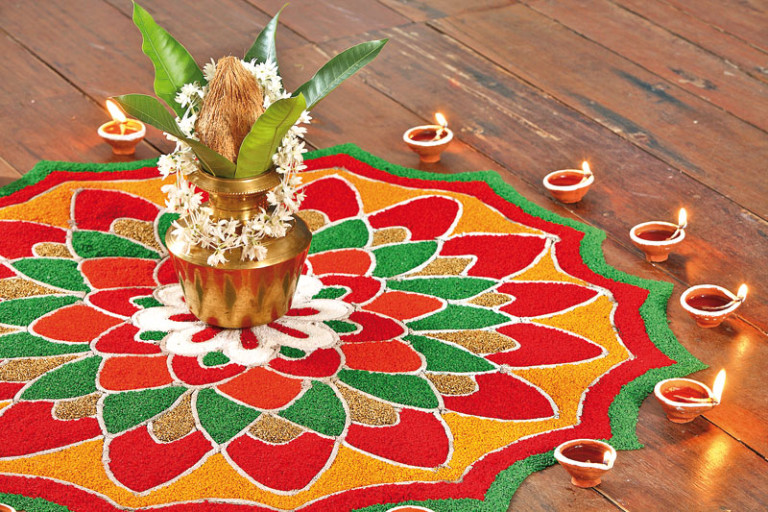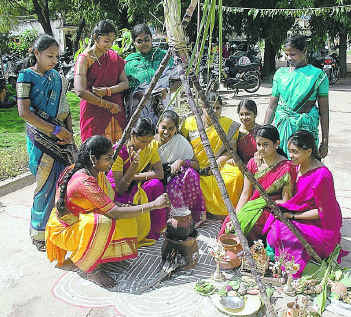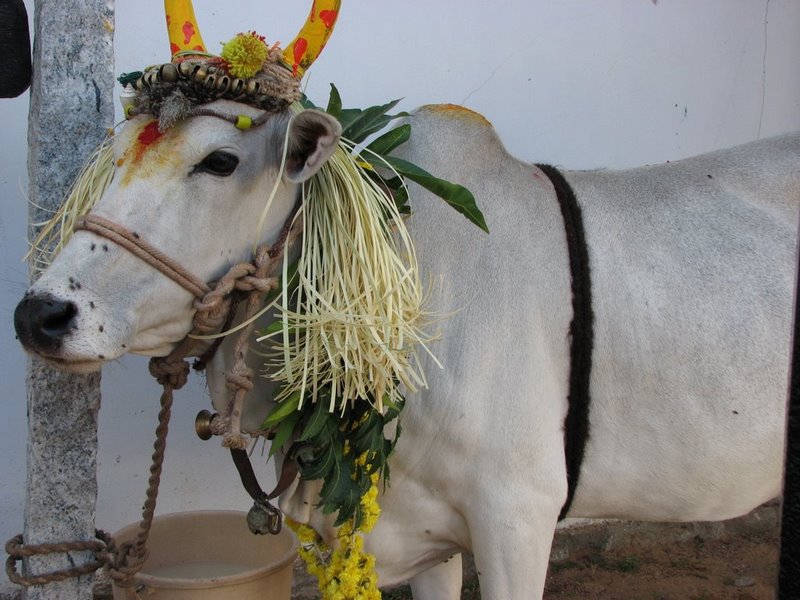Pongal – Great Indian Thanksgiving!

Pongal is one of the most popular festivals of South India, celebrated every year in mid-January, especially in Tamil Nadu. It is the festival to mark the harvest of crops and a special thanksgiving to God, the sun, the earth, and the cattle.
Seventy percent of India’s population lives in villages, and a vast majority of people solely depend on agriculture. As a result, we find that most Hindu festivals are directly or indirectly linked to agriculture and related activities.
What’s Pongal?
Festive Time for a Sunny Harvest!
‘Pongal’ comes from the word ‘ponga’ which literally means ‘boil’ and so ‘Pongal’ connotes ‘spillover’ or that which is ‘overflowing’. It’s also the name of the special sweet dish cooked on Pongal day. Pongal continues through the first four days of the ‘Thai’ month that starts on January 14 every year, so also called Thai Pongal.

Seasonal Festivity
Pongal is directly associated with the annual cycle of seasons. It not only marks the reaping of the harvest, but also the withdrawal of the southeast monsoons in southern India. As the cycle of the season rings out the old and ushers in the new, so is the advent of Pongal connected with cleaning up the old, burning down rubbish, and welcoming new crops.
Cultural & Regional Variations
Pongal in the state of Tamil Nadu is celebrated during the same time as ‘Bhogali Bihu’ in the North Eastern State of Assam, ‘Lohri‘ in Punjab, ‘Bhogi’ in Andhra Pradesh, and ‘Makar Sankranti‘ in the rest of the country, including Karnataka, Maharashtra, Uttar Pradesh, Bihar, and Bengal.
Assam’s ‘Bihu’ involves the early morning worship of Agni, the god of fire followed by a light long feast with family and friends. Bengal’s ‘Makar Sankranti‘ entails the preparation of traditional rice-sweets called ‘Pittha’ and the holy fair – Ganga Sagar Mela at the Ganga Sagar beach. In Punjab, it’s ‘Lohri’ – gathering around the sacred bonfire, feasting with family and friends, and exchanging greetings and pleasantries. And in Andhra Pradesh, it is celebrated as ‘Bhogi‘, when each household puts on display its collection of dolls.
Different Names of Pongal
- Tamil Nadu, Sri Lanka – celebrated as Pongal
- Andhra Pradesh, Bengal, Bihar, Goa, Karnataka, Orissa, Madhya Pradesh, Maharashtra, Manipur, Uttar Pradesh – celebrated as Makara Sankranthi or Sankranthi
- Gujarat and Rajasthan celebrated as Uttarayana
- Haryana, Himachal Pradesh, and Punjab – celebrated as Lohri
- Assam – celebrated as Magh Bihu or Bhogali Bihu
- Nepal – celebrated as Maghe Sankranthi
Four Days of Festivity
Pongal in 2025 begins on January 13 and ends on January 16.
Pongal follows the winter solstice and marks the favorable course of the sun. On the first day, the sun is worshipped, signifying its movement from Cancer to Capricorn. This is also why, in other parts of India, this harvest festival and Thanksgiving is called ‘Makar Sankranti‘. [Sanskrit Makar = Capricorn]
Each day of the four-day festival has its own name and distinct fashion of celebration.
Day 1: Bhogi Pongal
Bhogi Pongal is a day for the family, for domestic activities, and for being together with the members of the household. This day is celebrated in honor of Lord Indra, “the Ruler of Clouds and Giver of Rains“.
On the first day of Pongal a huge bonfire is lit at dawn in front of the house and all old and
useless items are set ablaze, symbolic of beginning a fresh new year. The bonfire burns through the night as young people beat little drums and dance around it. Homes are cleaned and decorated with “Kolam” – floor designs drawn in the white paste of newly harvested rice with outlines of red mud. Often pumpkin flowers are set into cow-dung balls and placed among the patterns. Fresh harvest of rice, turmeric, and sugarcane are brought in from the field as preparation for the following day.
Day 2: Surya Pongal
The second day is dedicated to Lord Surya, the Sun God, who is offered boiled milk and jaggery. A plank is placed on the ground, a large image of the Sun God is sketched on it and Kolam designs are drawn around it. This icon of the Sun God is worshipped for divine benediction as the new month of ‘Thai’ begins.
Day 3: Mattu Pongal

This third day is meant for the cattle (‘Mattu’) – the giver of milk and puller of the plow. The farmer’s ‘dumb friends‘ are given a good bath, their horns are polished, painted, and covered with metal caps, and garlands are put around their necks. The Pongal that has been offered to the gods is then given to the cattle to eat. They are then taken out to the racing tracks for cattle race and bullfight – an event full of festivity, fun, frolic, and revelry.
Day 4: Kanya Pongal / Thiruvalluvar Day
The fourth and final day marks the Kanya Pongal, in Tamil Nadu, it may be called Uzhavar Tirunal. in a few places, this day is also known as Karinaal or Thiruvalluvar Day. It is dedicated to the sun god, Surya, and has its roots in ancient Brahminical tradition, this day birds are worshipped. Girls prepare colored balls of cooked rice and keep them in the open for birds and fowls to eat. On this day sisters also pray for their brothers’ happiness.
Tales & Legends
Like all Hindu festivals, Pongal has some interesting legends attached to it. But surprisingly, this festival has little or no mention in the Puranas, which are usually bristled with tales and legends related to festivals. This is perhaps because Pongal is preeminently a Dravidian harvest festival and has somehow managed to keep itself away from the preponderance of Indo-Aryan influences.
The Mt. Govardhan Tale
The most popular Pongal legend is the one associated with the first day of the celebrations when Lord Indra is worshipped. The story behind it is, on this day Indra being honored by all became proud and arrogant. To teach him a lesson, Lord Krishna asked his cowherd friends to worship Mount Govardhan instead of Indra on the Bhogi Pongal day.
Awfully infuriated, Indra sent forth the clouds to generate thunder, lightning, and heavy rains and flood the land. But, as the tale goes, Lord Krishna lifted up the Govardhan Mountain on his little finger and sheltered the farmers, cowherd, and their cattle. Indra then begged Shri Krishna’s forgiveness and the latter re-permitted Bhogi celebrations in honor of Indra.
The Nandi Bull Story
According to another legend associated with Mattu Pongal, on the third day of celebrations, Lord Shiva once asked his Nandi bull to go to earth and deliver a special message to his disciples: “Have an oil bath every day, and food once a month.”
But the baffled bovine failed to deliver the correct message. He told the people that Shiva asked them to “have an oil bath once a month and food every day.” The enraged Shiva then ordered Nandi to stay back on earth and help the people plow the fields since they would now need to grow more grains.






